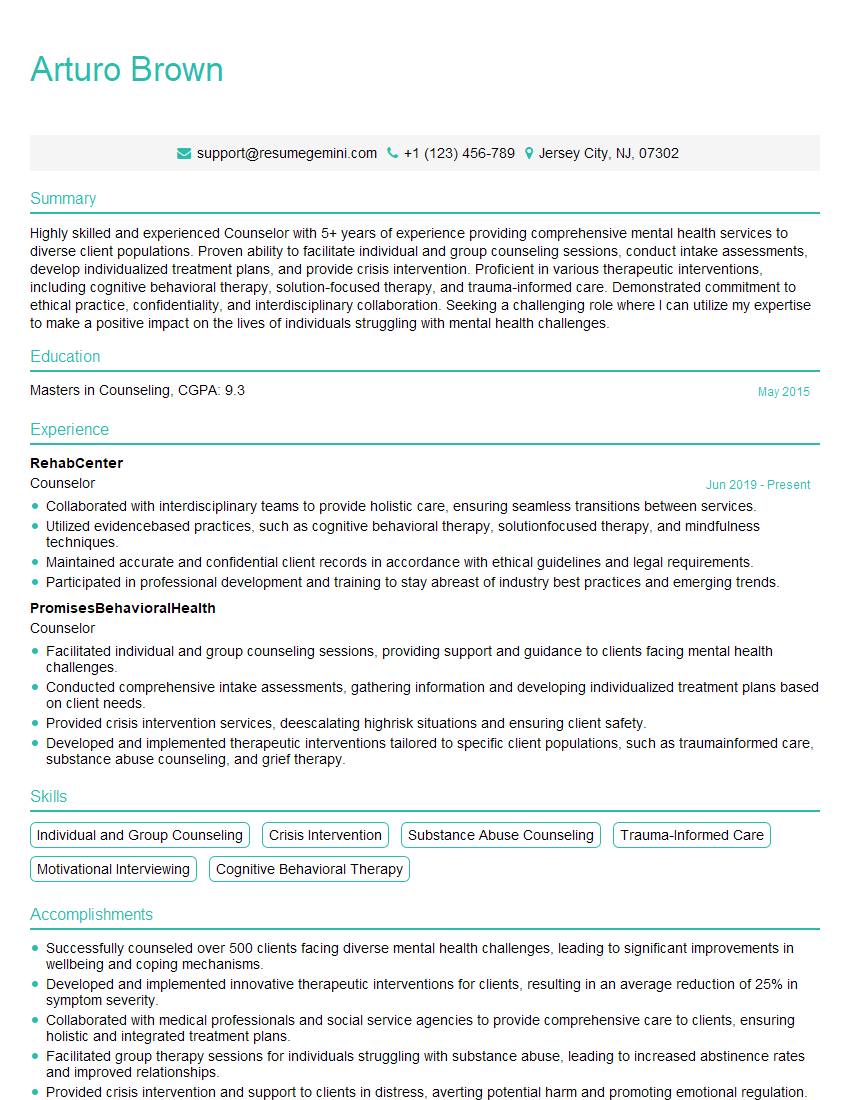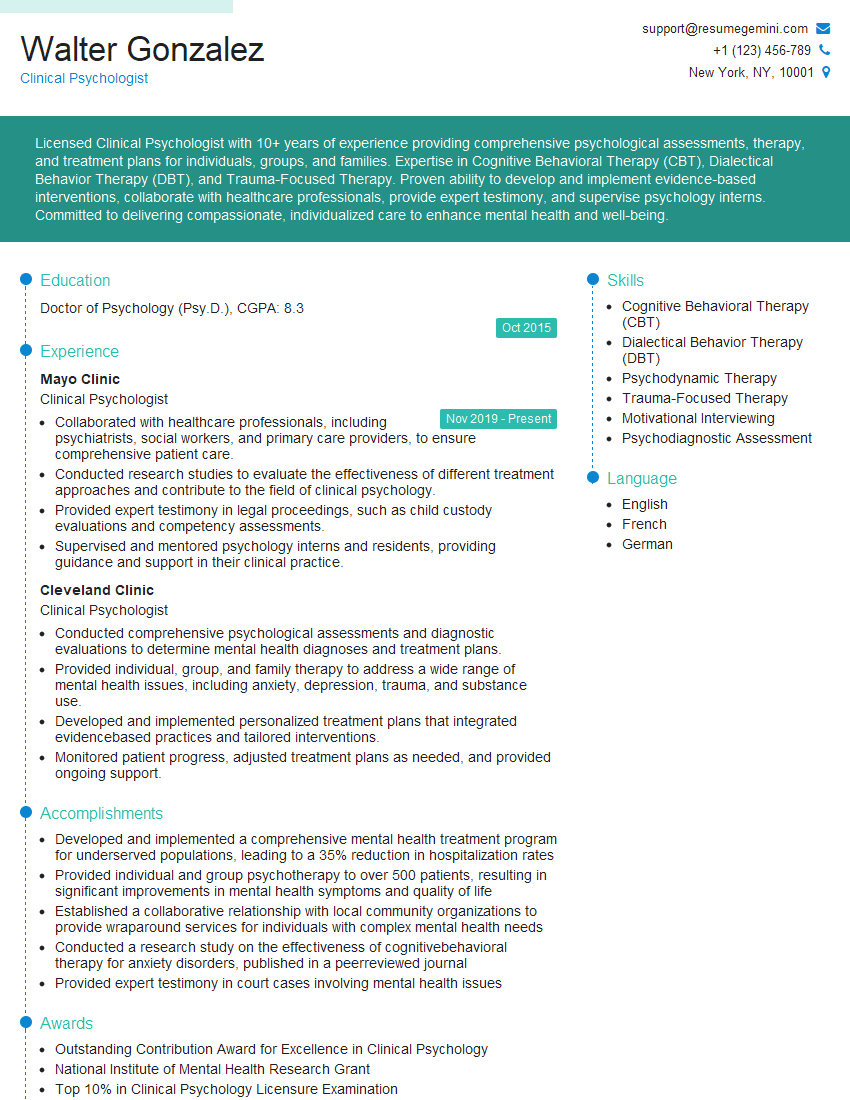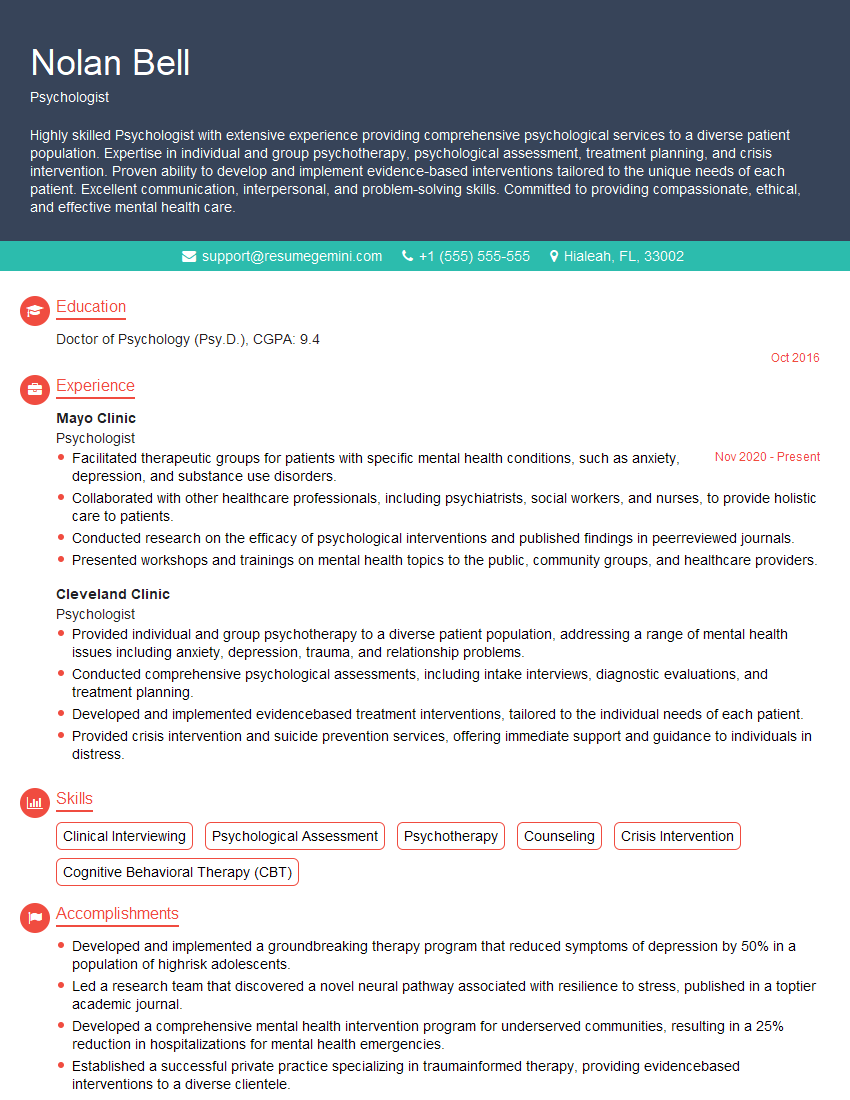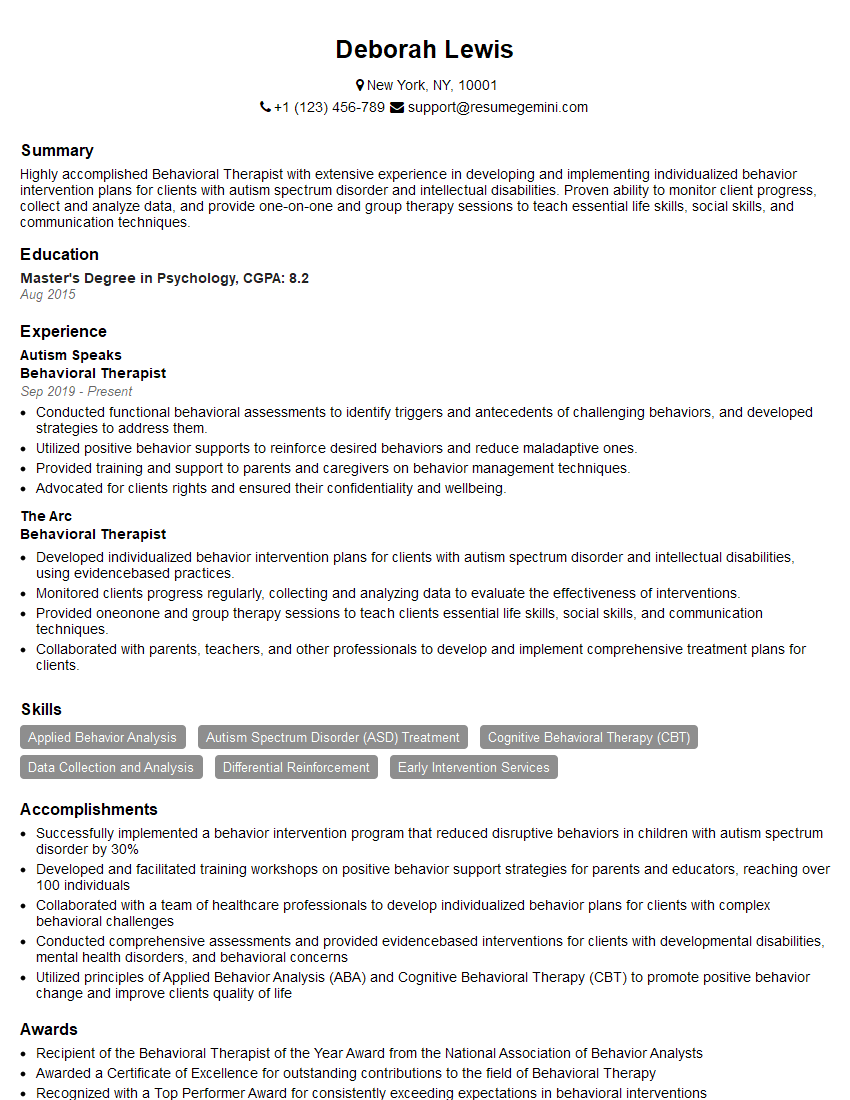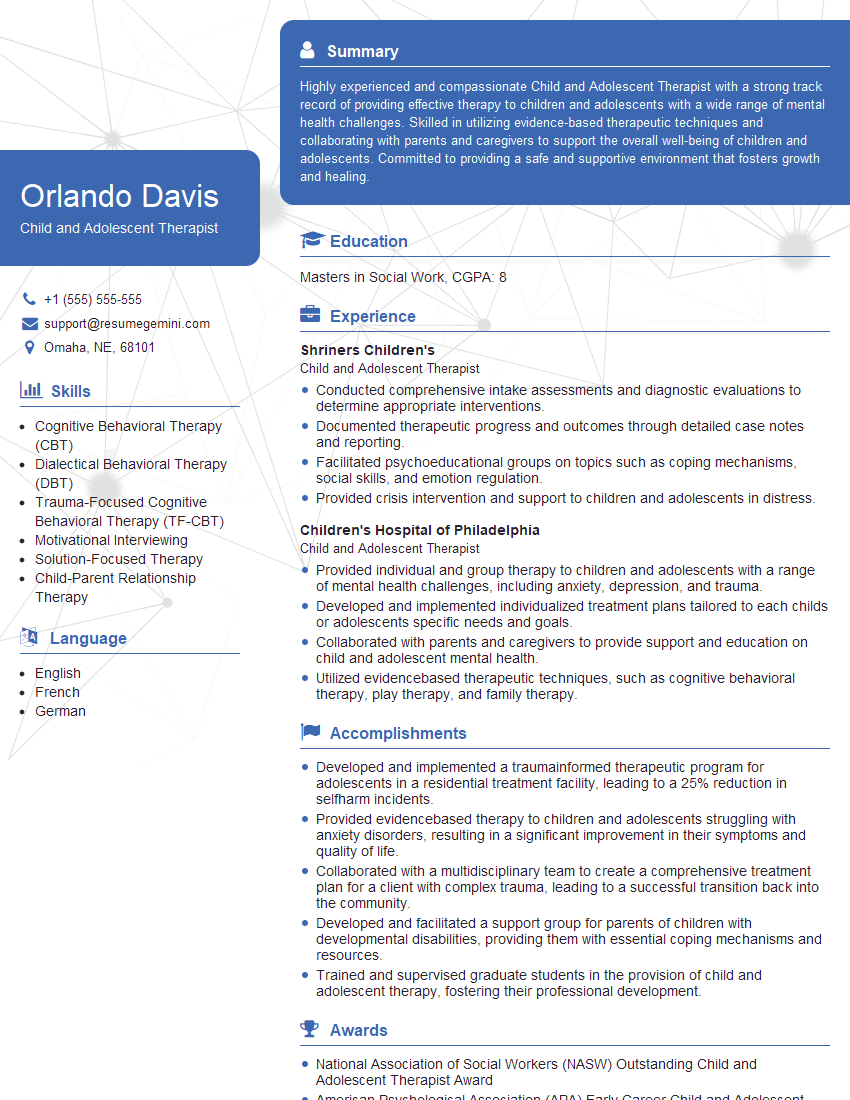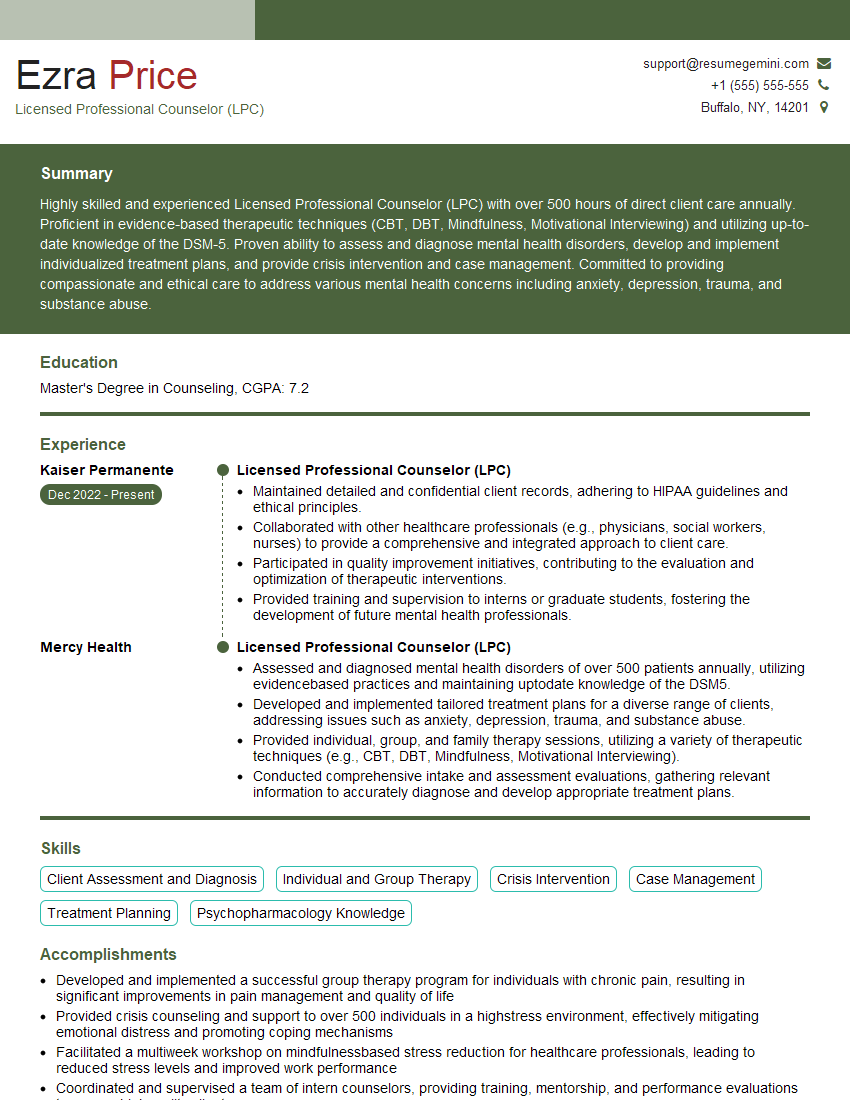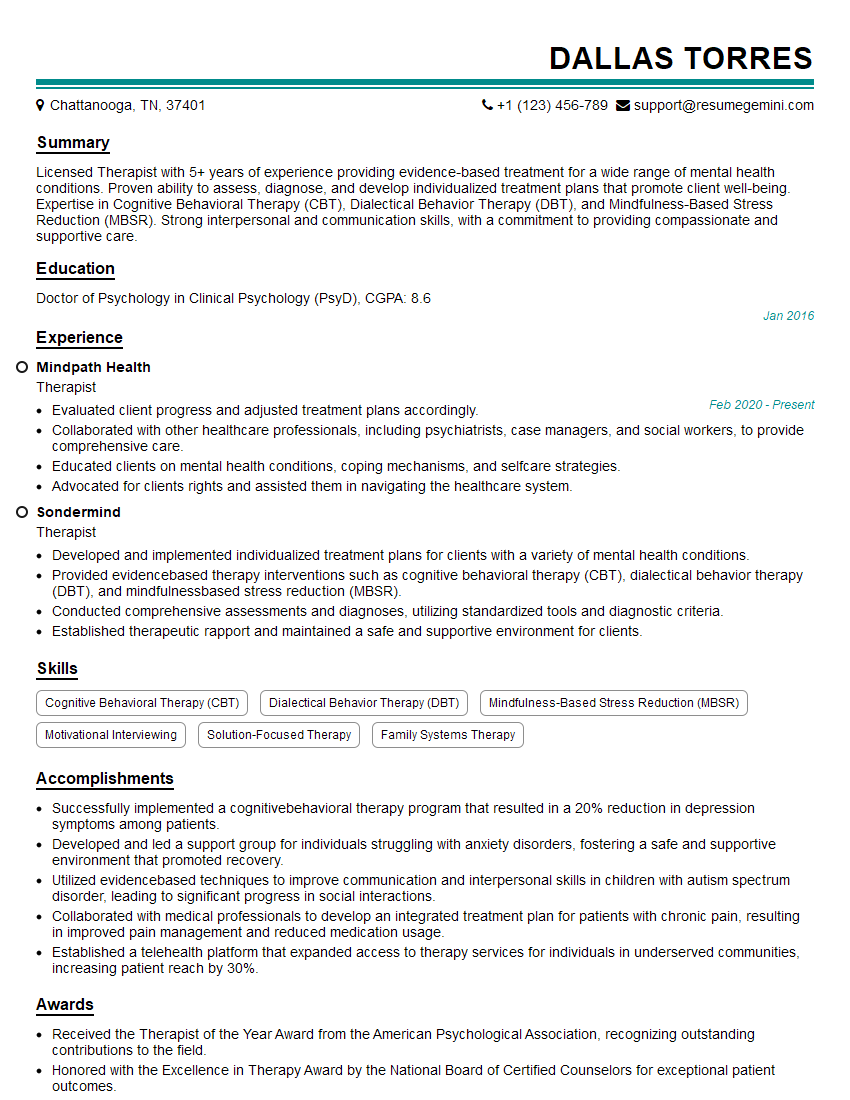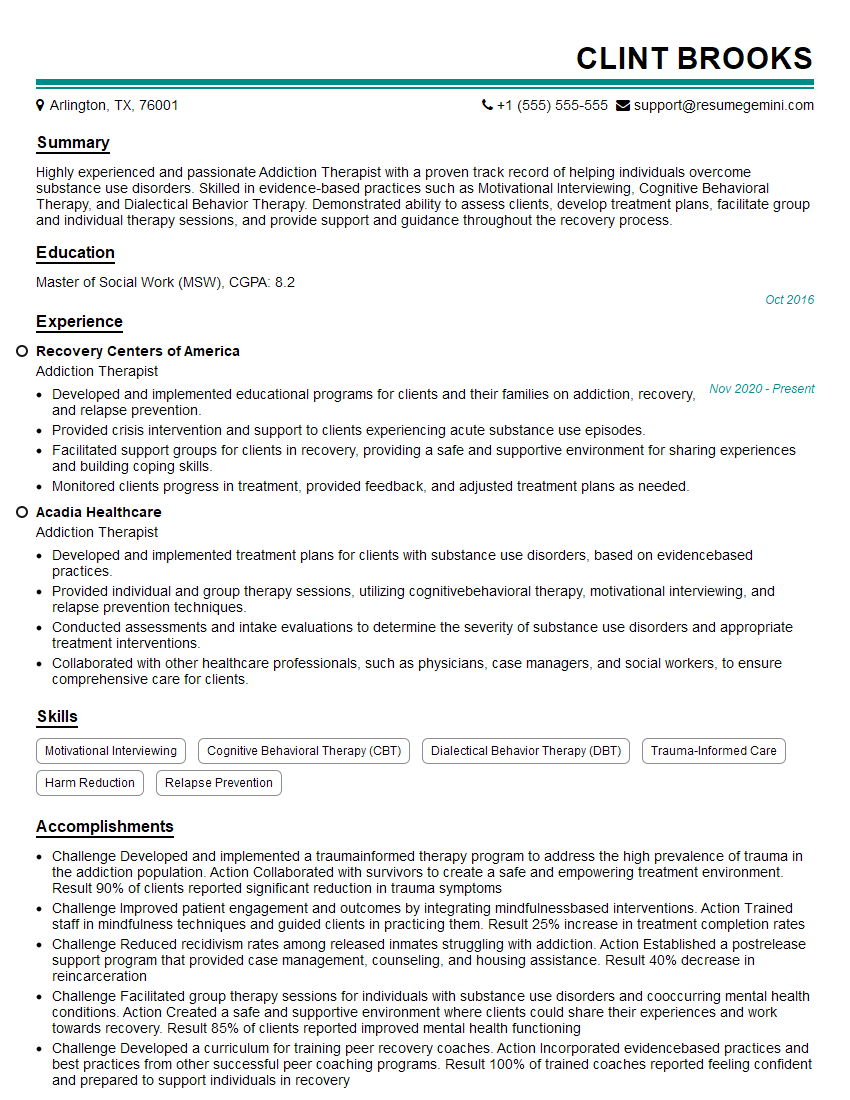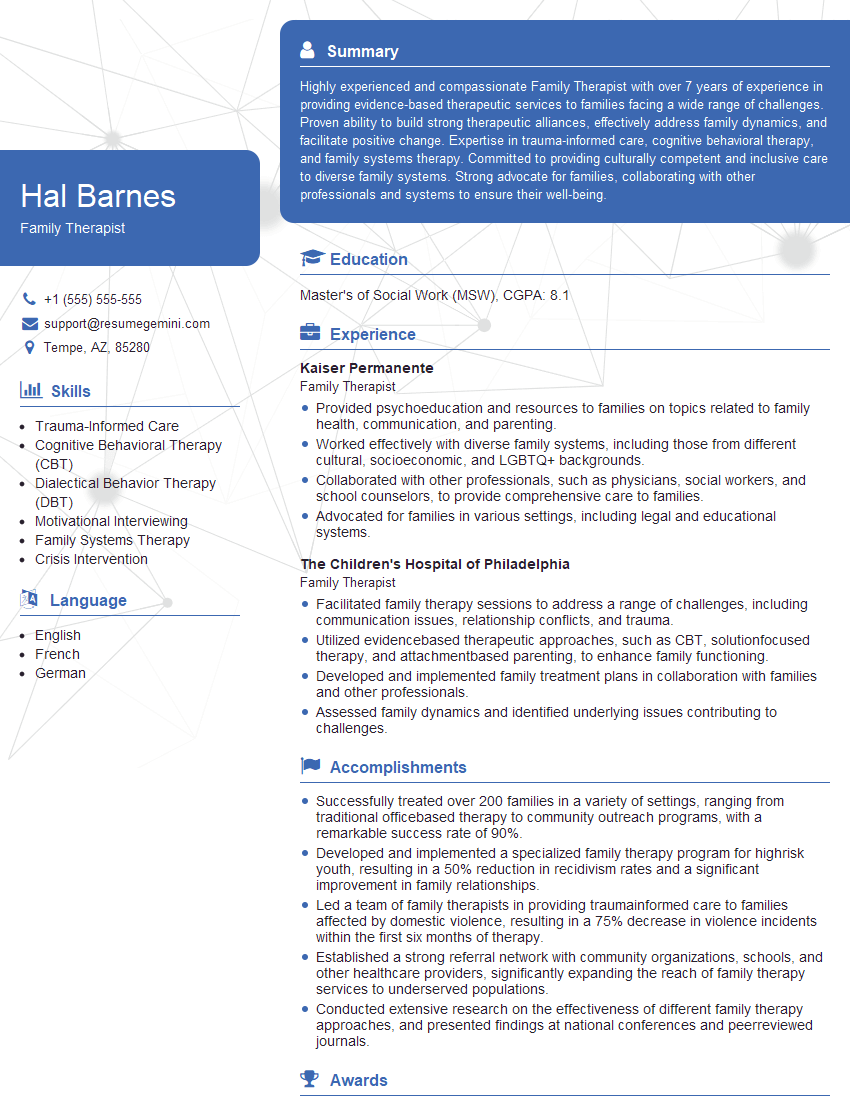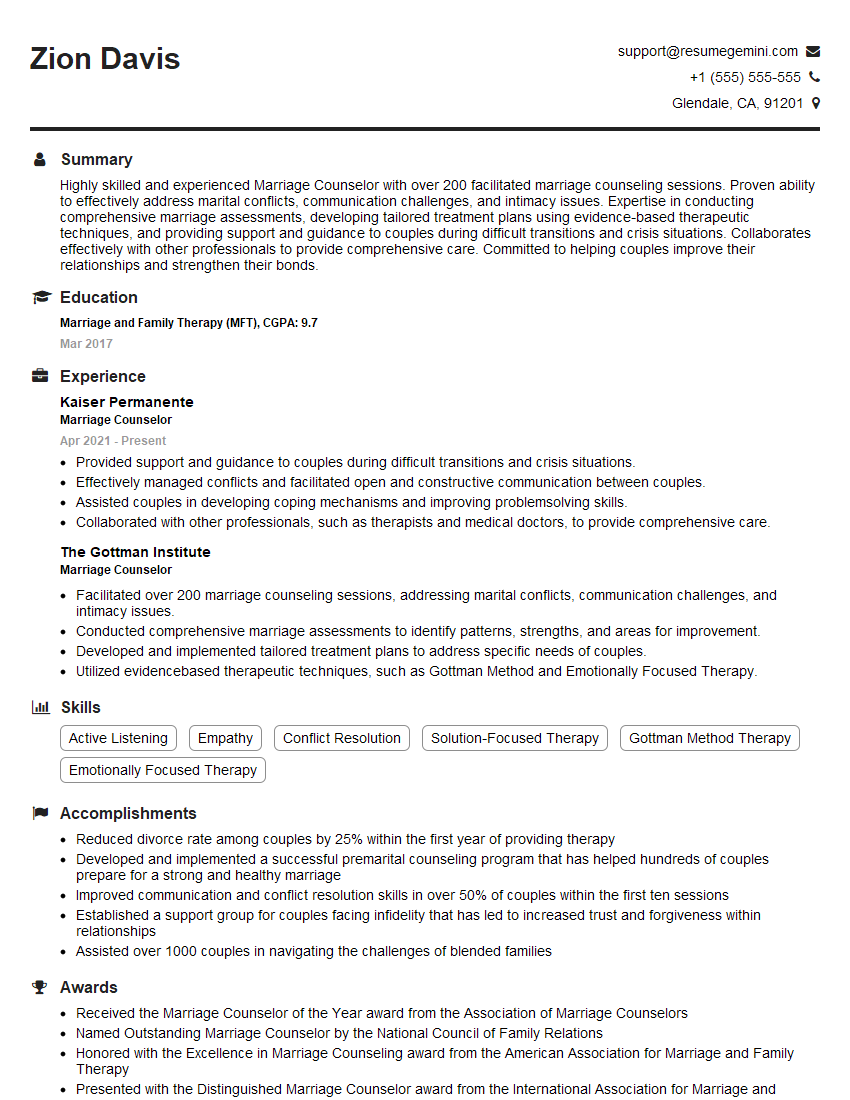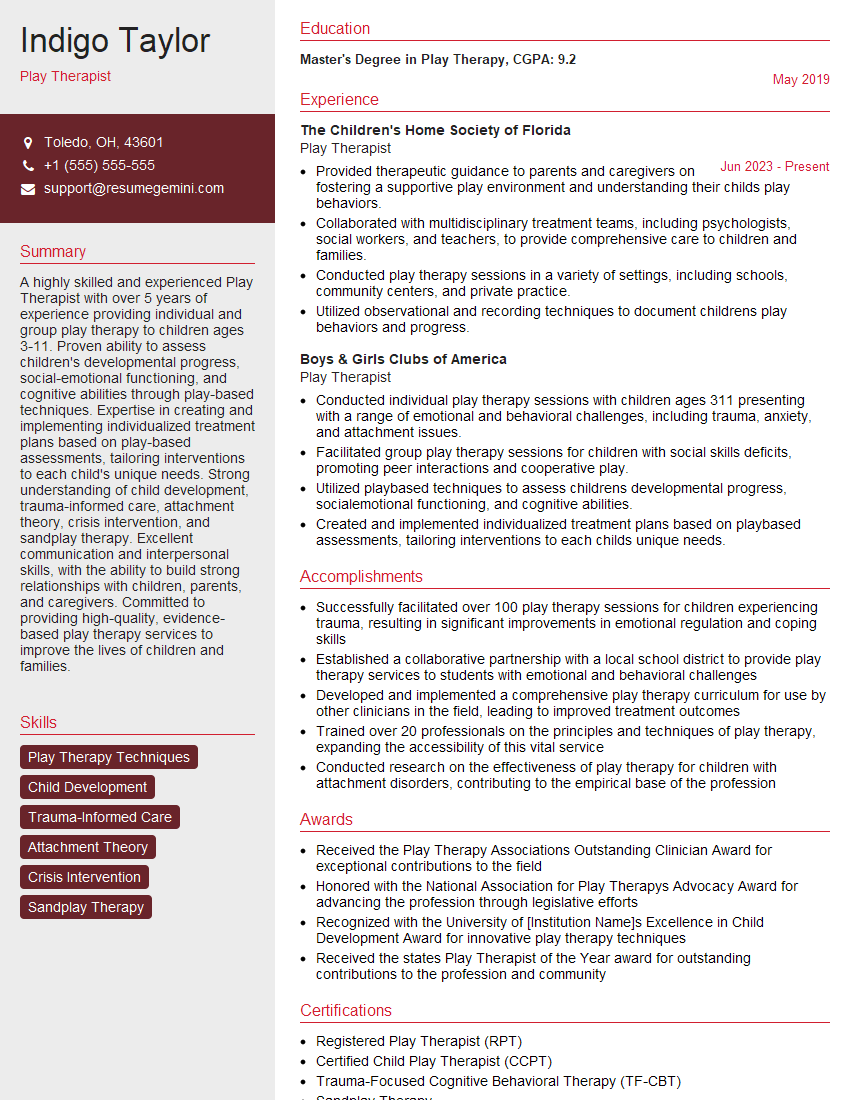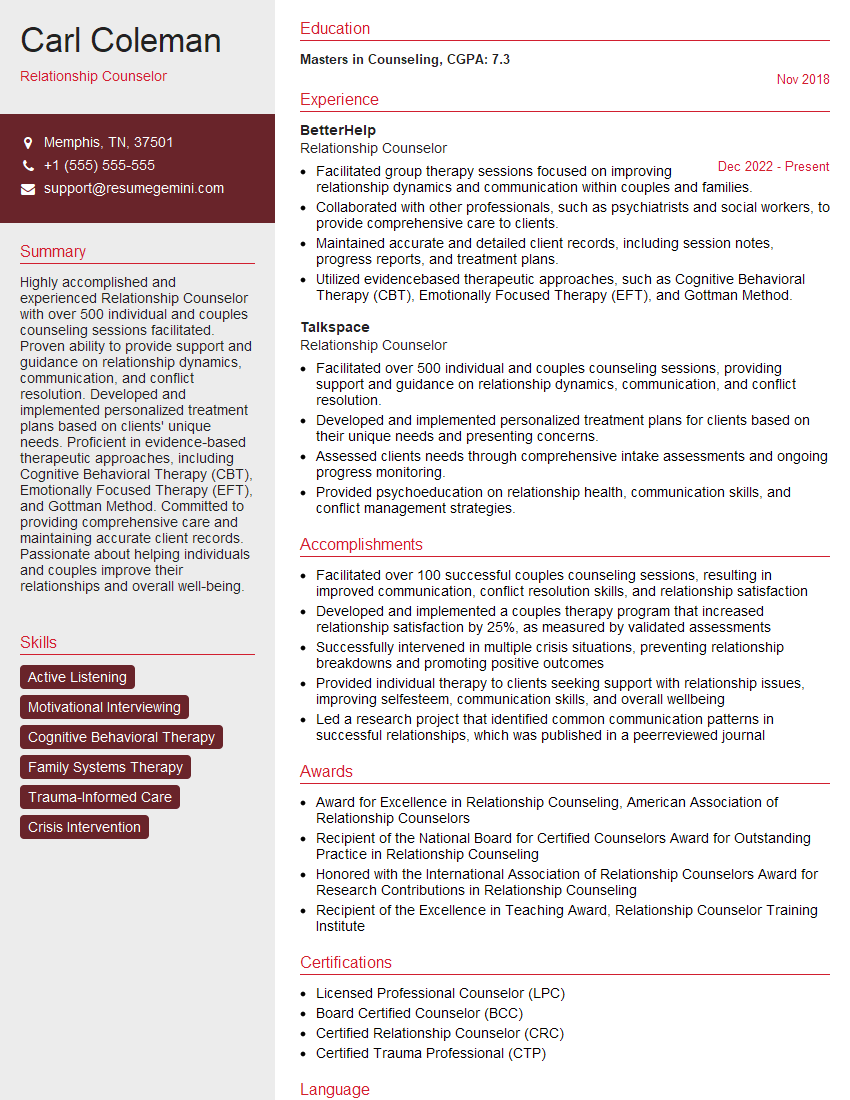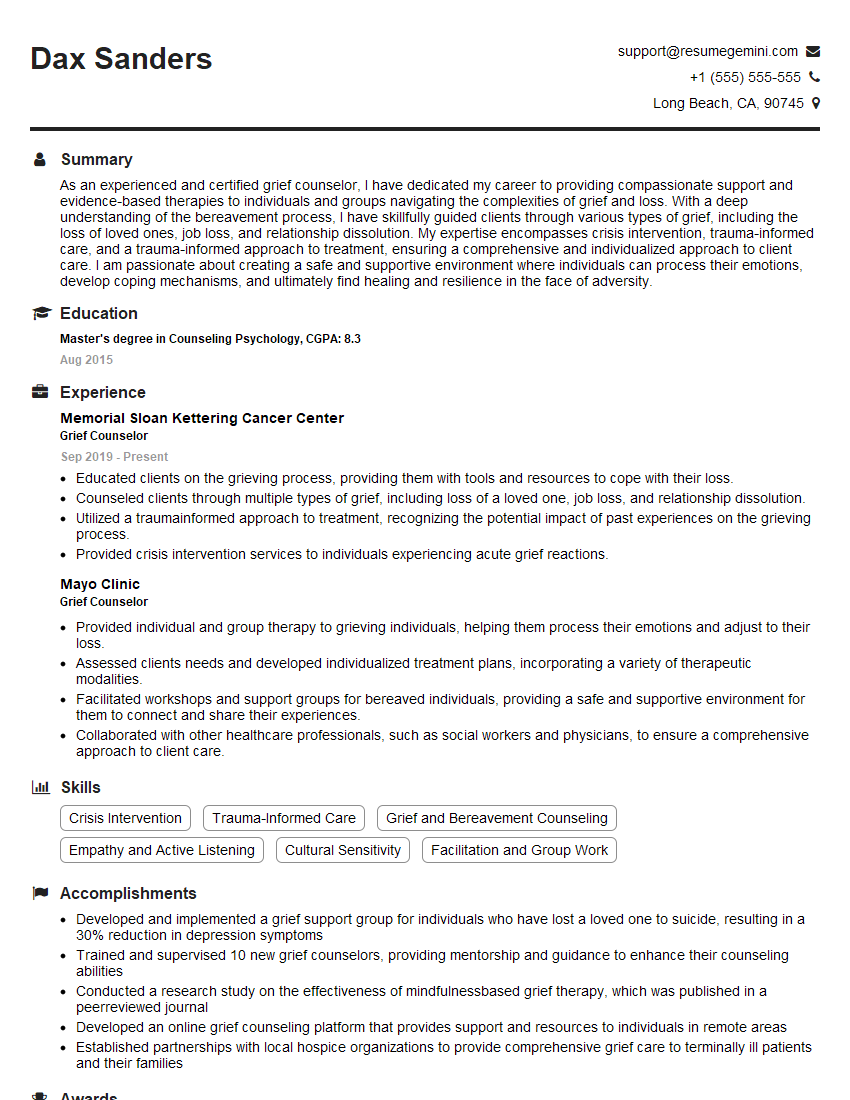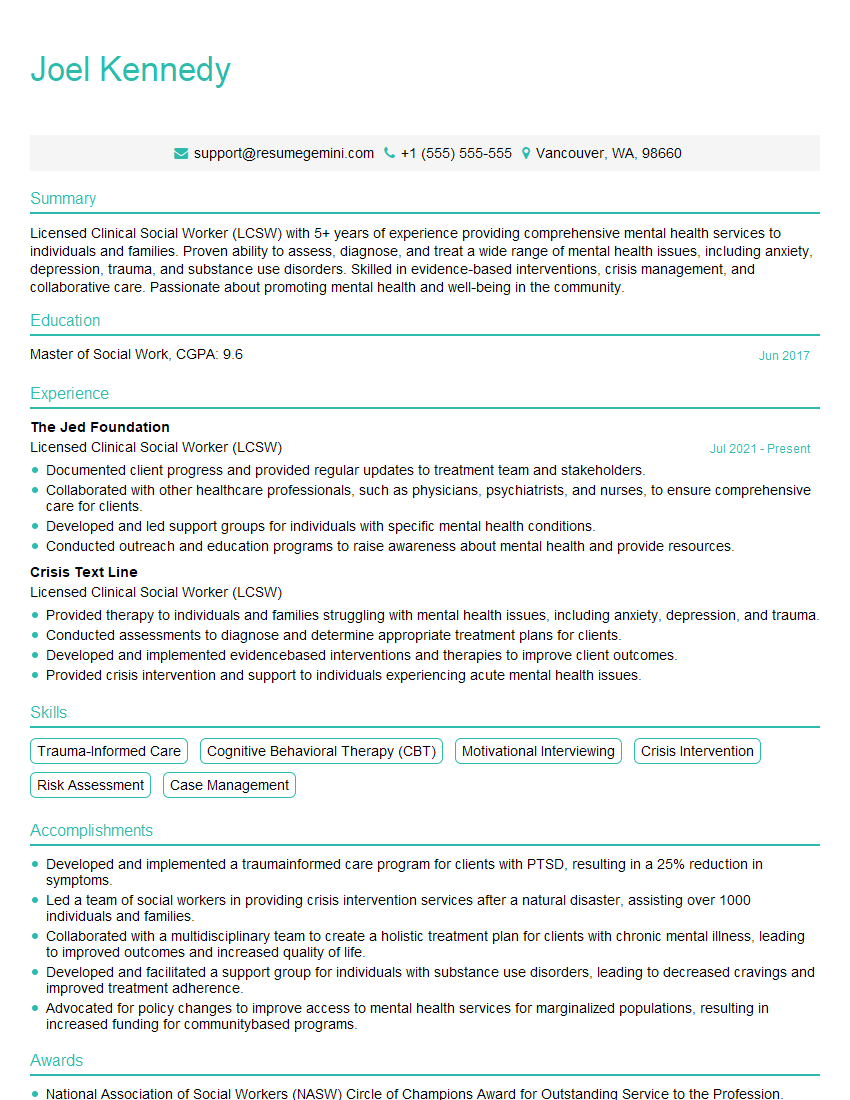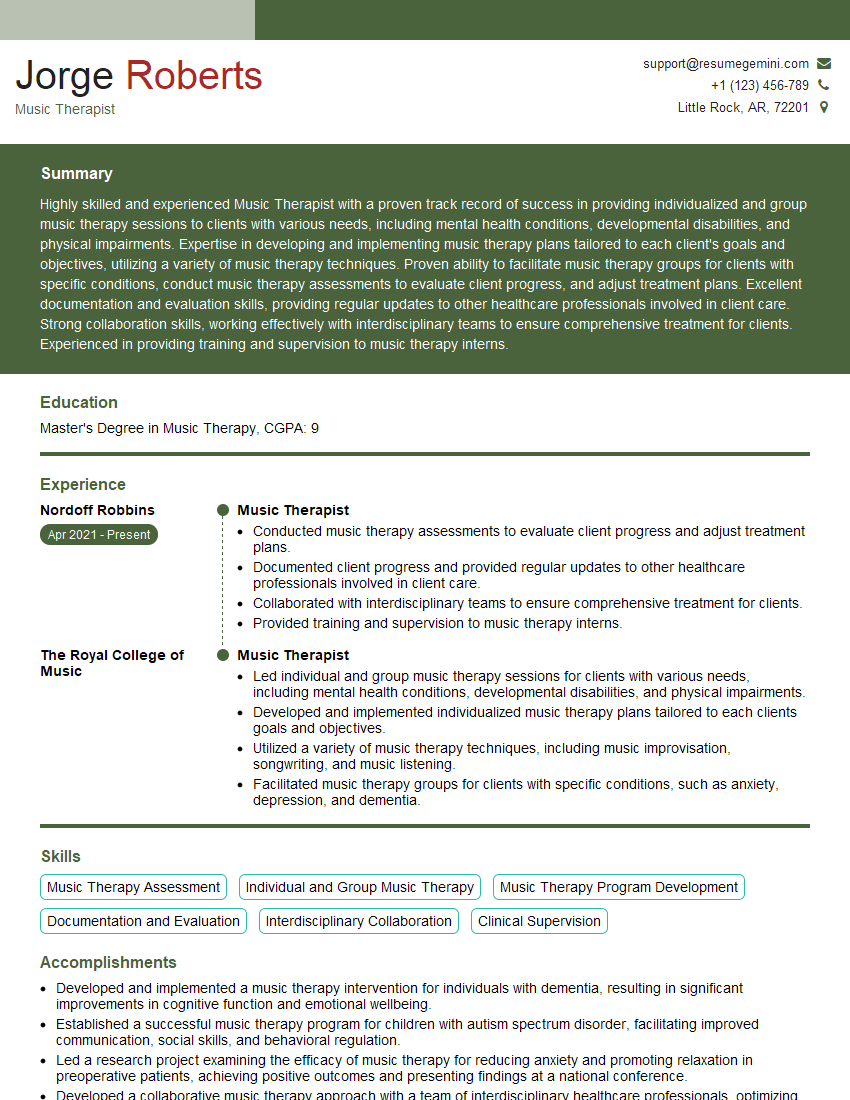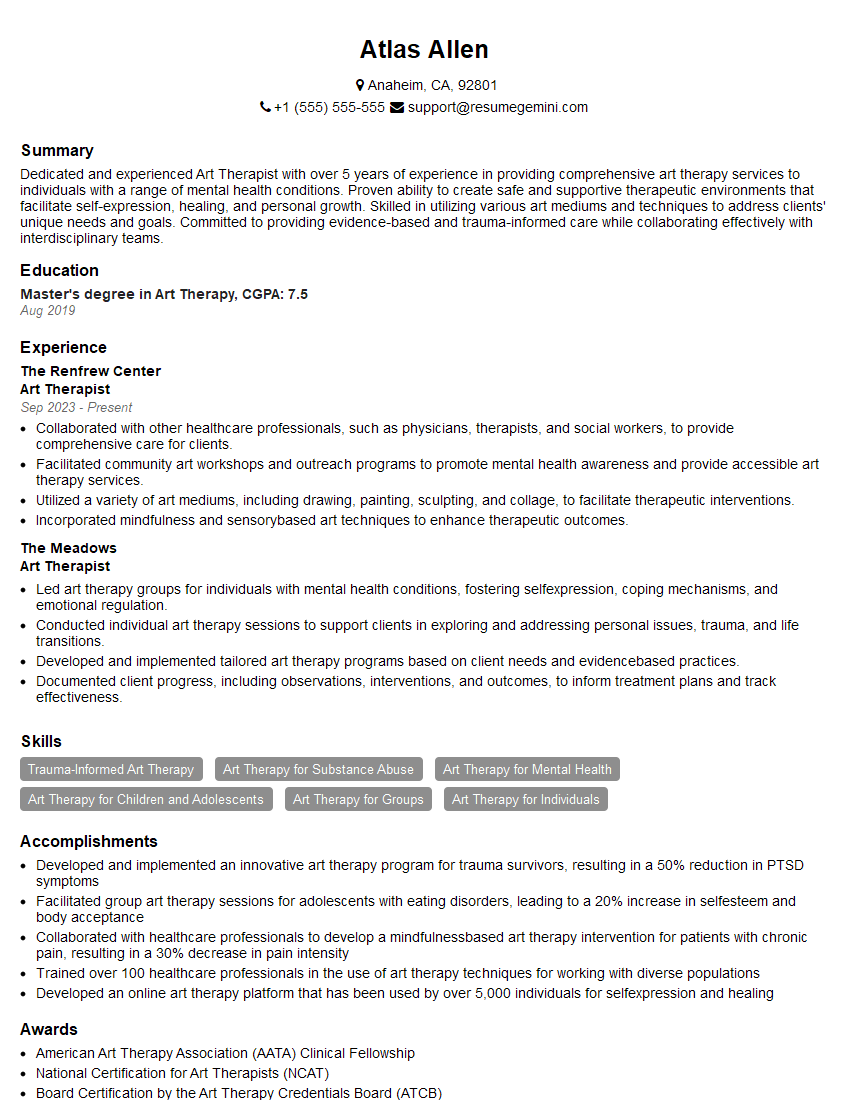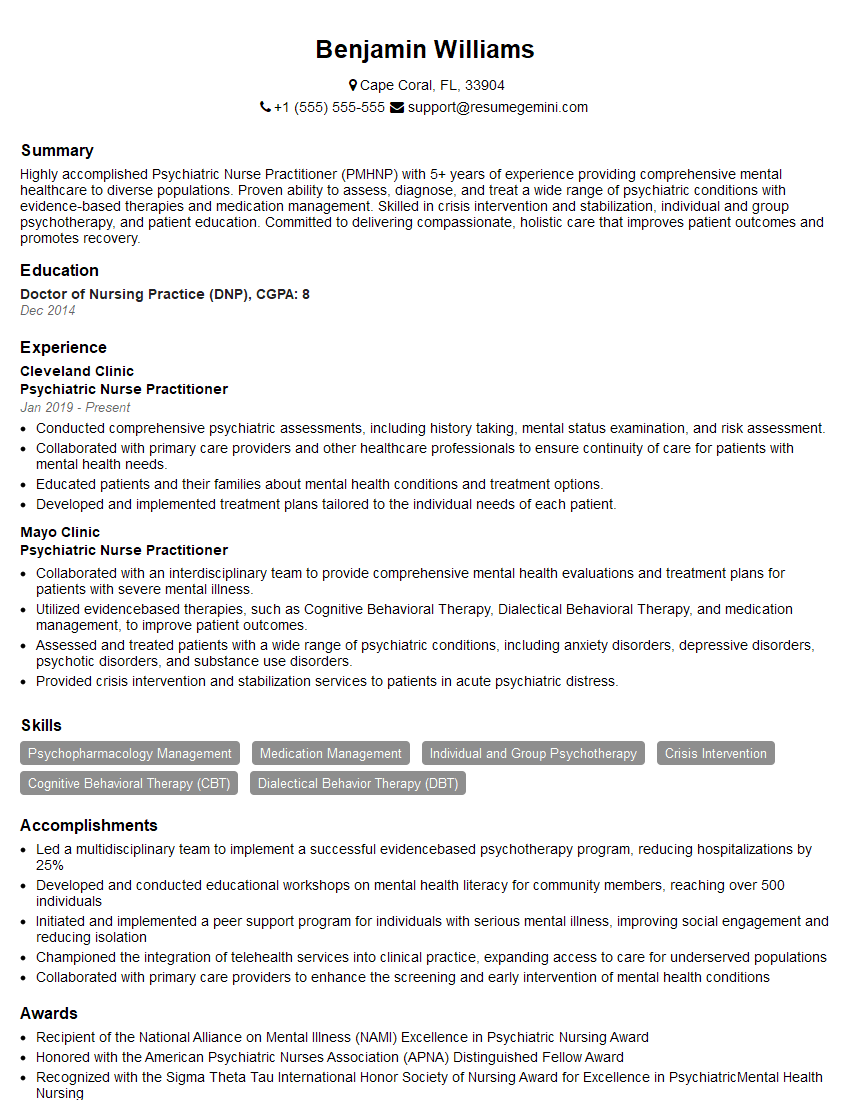Preparation is the key to success in any interview. In this post, we’ll explore crucial Individual Psychotherapy interview questions and equip you with strategies to craft impactful answers. Whether you’re a beginner or a pro, these tips will elevate your preparation.
Questions Asked in Individual Psychotherapy Interview
Q 1. Explain the differences between psychodynamic, cognitive-behavioral, and humanistic approaches to therapy.
The three approaches – psychodynamic, cognitive-behavioral (CBT), and humanistic – offer distinct perspectives on the causes and treatment of mental distress. Think of them as three different roads leading to a similar destination: improved mental well-being.
- Psychodynamic therapy delves into the unconscious mind, exploring past experiences and their impact on present behavior. It emphasizes the role of early childhood relationships and unresolved conflicts in shaping personality and mental health. For example, a recurring pattern of relationship difficulties might be traced back to unresolved attachment issues from childhood. The therapist helps the client uncover these unconscious patterns through techniques like free association and dream analysis.
- Cognitive-behavioral therapy (CBT) focuses on the present, targeting maladaptive thoughts and behaviors. It’s based on the idea that our thoughts influence our feelings and behaviors. For instance, if a client experiences anxiety due to negative thoughts about a public speaking engagement, CBT would involve identifying and challenging these negative thoughts, replacing them with more realistic and helpful ones, and practicing coping mechanisms.
- Humanistic therapy emphasizes personal growth and self-actualization. It views individuals as inherently good and capable of self-direction. The therapist acts as a facilitator, helping the client explore their values, identify their strengths, and overcome obstacles that hinder their self-discovery. This approach might involve techniques like active listening and unconditional positive regard to foster self-acceptance and personal growth.
In essence, psychodynamic therapy looks to the past, CBT focuses on the present, and humanistic therapy emphasizes the future and the client’s potential.
Q 2. Describe your preferred method for assessing a client’s presenting problem.
My preferred method for assessing a client’s presenting problem is a comprehensive approach combining clinical interviews, psychological assessments, and collateral information where appropriate. The process begins with a thorough clinical interview, allowing me to understand the client’s subjective experience, history, and current challenges in their own words. This initial conversation is crucial for building rapport and gathering information.
Depending on the nature of the presenting problem, I might utilize standardized psychological assessments like personality inventories (e.g., MMPI-2-RF) or symptom checklists (e.g., Beck Depression Inventory). These tools provide objective data to support clinical judgment. Finally, obtaining collateral information from family members or other relevant professionals (with the client’s informed consent) can provide valuable context and perspectives.
Imagine a client presenting with depression. The interview would explore their symptoms, life events, family history, and coping mechanisms. A depression inventory could quantify the severity of their symptoms. If relevant, information from a family member about the client’s recent behavior could provide additional insights. This multi-faceted approach allows for a more nuanced and accurate understanding of the client’s situation.
Q 3. How do you establish rapport and build a therapeutic alliance with clients?
Establishing rapport and building a therapeutic alliance is fundamental to successful therapy. It’s about creating a safe and trusting environment where the client feels comfortable sharing vulnerable information. I achieve this through several key strategies:
- Empathy and active listening: I actively listen to the client’s story, reflecting their feelings and showing genuine understanding. This communicates that I value their experience and perspective.
- Respect and unconditional positive regard: I treat each client with respect, regardless of their background or challenges. I accept them as they are, fostering a sense of safety and acceptance.
- Collaboration and shared goals: I work collaboratively with the client to define therapeutic goals and collaboratively develop a treatment plan. This ensures the client feels in control of the process.
- Transparency and self-disclosure (appropriately): Sharing relevant aspects of my professional role and therapeutic approach fosters trust and mutual understanding, though I maintain appropriate boundaries.
For example, I might start a session by acknowledging the courage it takes to seek therapy and validate the client’s feelings. Throughout sessions, my nonverbal cues, like maintaining eye contact and nodding appropriately, demonstrate active engagement and create a secure therapeutic space.
Q 4. What are the ethical considerations involved in maintaining client confidentiality?
Maintaining client confidentiality is paramount and governed by strict ethical guidelines. Ethical considerations include:
- Informed consent: Clients must be fully informed about the limits of confidentiality before treatment begins, including situations where disclosure is legally mandated (e.g., child abuse, imminent harm to self or others).
- Duty to warn/protect: If a client poses a credible threat of harm to themselves or others, I have a legal and ethical obligation to take appropriate steps, which may involve breaching confidentiality to protect individuals at risk. This is always done with careful consideration and, whenever possible, involving collaboration with the client.
- Data security: I utilize secure electronic health record systems to protect client information from unauthorized access.
- Supervision and consultation: When faced with challenging ethical dilemmas, I seek guidance from supervisors or colleagues to ensure I’m making informed decisions.
For instance, a client disclosing past abuse would be handled confidentially unless legal mandates requiring reporting were met. Similarly, if a client expresses serious suicidal intent, steps would be taken to ensure their safety, potentially involving contacting emergency services.
Q 5. How do you handle a client who is experiencing suicidal ideation?
Suicidal ideation requires immediate and serious attention. My response involves several steps:
- Assess the risk: I’d conduct a thorough assessment of the client’s suicidal thoughts, plans, and intent, including access to lethal means. This involves asking direct, open-ended questions.
- Develop a safety plan: Collaboratively, we would create a safety plan with concrete steps the client can take to manage suicidal thoughts and urges. This plan might involve identifying support systems, developing coping strategies, and restricting access to potentially lethal means.
- Involve support systems: With the client’s consent, I may contact family members or friends to provide additional support.
- Consider hospitalization: If the risk of suicide is imminent and severe, I would recommend hospitalization for crisis intervention and stabilization.
- Ongoing support and monitoring: I would provide ongoing support and monitor the client closely, adjusting the treatment plan as needed.
It’s vital to remember that suicidal ideation is a symptom, not a character flaw. My role is to help the client through this crisis while addressing the underlying issues contributing to their distress.
Q 6. Describe your approach to managing countertransference.
Countertransference refers to the therapist’s unconscious emotional reactions to the client. Managing countertransference is crucial for maintaining objectivity and providing effective therapy. My approach involves several strategies:
- Self-awareness: Regular self-reflection is key. I actively monitor my emotional responses during sessions and identify any patterns or triggers.
- Supervision: I regularly engage in supervision with a qualified professional to discuss cases and process my countertransference reactions. This provides an external perspective and helps me maintain professional boundaries.
- Personal therapy: Engaging in my own personal therapy is essential for self-care and managing my own emotional well-being, which directly impacts my ability to manage countertransference.
- Maintaining professional boundaries: I strictly adhere to professional boundaries to prevent countertransference from impacting the therapeutic relationship.
For example, if I find myself becoming overly invested in a client’s personal life, I’d use supervision to explore the reasons for this emotional response, ensuring I maintain a professional stance while still providing compassionate care.
Q 7. What are your strategies for working with clients from diverse cultural backgrounds?
Working with clients from diverse cultural backgrounds requires cultural humility and sensitivity. My strategies include:
- Cultural self-awareness: I acknowledge my own cultural biases and limitations. Understanding my own cultural lens is crucial for avoiding misinterpretations.
- Cultural competence training: Ongoing professional development in cultural competence expands my understanding of various cultural perspectives and practices.
- Client-centered approach: I prioritize the client’s unique cultural context and values, adapting my therapeutic approach accordingly.
- Collaboration and consultation: When necessary, I consult with colleagues or community resources who possess expertise in specific cultural groups.
- Avoiding cultural imposition: I avoid imposing my own cultural values or beliefs on the client, instead respecting their unique worldview.
For example, understanding a client’s cultural norms around communication styles, family roles, and expressions of emotion is vital for building trust and tailoring my therapeutic approach to meet their specific needs. This might involve adjusting my communication style or incorporating culturally relevant interventions.
Q 8. How do you incorporate evidence-based practices into your clinical work?
Evidence-based practice (EBP) in psychotherapy means integrating the best available research with clinical expertise and client values to inform treatment decisions. I prioritize utilizing therapies with strong empirical support for their efficacy. For example, Cognitive Behavioral Therapy (CBT) is highly effective for treating anxiety disorders, and I frequently incorporate CBT techniques like cognitive restructuring and exposure therapy. Similarly, for depression, I may use techniques from interpersonal therapy (IPT) focusing on improving social relationships and communication patterns, alongside medication management in collaboration with a psychiatrist when appropriate. My approach isn’t solely about applying specific techniques; it’s about selecting and tailoring interventions to fit each individual’s unique needs and preferences, always critically evaluating the evidence supporting each choice and openly discussing the rationale with the client.
For instance, a client struggling with social anxiety might benefit from a combination of CBT techniques to challenge negative thoughts and exposure exercises to gradually increase social interactions. The treatment plan would be collaboratively developed, taking into account the client’s specific fears, goals, and preferences for therapy. Regular assessment of progress ensures we remain flexible and adapt the approach as needed.
Q 9. Explain your understanding of the Diagnostic and Statistical Manual of Mental Disorders (DSM-5).
The Diagnostic and Statistical Manual of Mental Disorders, 5th Edition (DSM-5), is a widely used classification system for mental disorders. It provides a standardized framework for diagnosing and understanding various mental health conditions. It’s crucial to understand that the DSM-5 is a tool, not a definitive explanation of a person’s experience. Diagnoses are not labels but rather descriptive summaries of symptoms that help guide treatment planning and communication among professionals. The DSM-5 organizes diagnoses into different categories, detailing diagnostic criteria for each disorder. It doesn’t explain the *cause* of the disorder but describes observable symptoms and their patterns.
I use the DSM-5 as a helpful guide in the assessment process, paying close attention to the client’s subjective experience and the context of their life. The diagnostic process involves a thorough clinical interview and potentially additional assessments to arrive at a comprehensive understanding. However, I emphasize that a DSM-5 diagnosis is just one piece of the puzzle. It informs my understanding, but the client’s unique story and goals remain central to our work together.
Q 10. How do you address resistance in therapy?
Resistance in therapy refers to behaviors or attitudes that impede the therapeutic process. This can manifest in various ways, such as missing appointments, intellectualizing, or minimizing problems. It’s rarely a deliberate attempt to sabotage therapy but often stems from underlying anxieties or defenses related to exploring difficult emotions or past experiences. Instead of viewing resistance as negative, I see it as an opportunity to understand the client’s experience and to collaboratively work through these challenges.
My approach involves exploring the *function* of resistance – what purpose it serves for the client. I might gently inquire about the reasons behind missed sessions or hesitancy to engage in specific exercises. Building a strong therapeutic alliance and creating a safe space for exploration is essential. For example, if a client consistently minimizes their problems, I might collaboratively examine the potential consequences of avoiding deeper exploration. The process is always collaborative, focusing on helping the client understand the patterns and collaboratively finding strategies to manage or overcome them. Instead of directly confronting resistance, I prioritize understanding its root cause.
Q 11. Describe your process for developing a treatment plan.
Developing a treatment plan is a collaborative process, beginning with a thorough assessment of the client’s presenting problems, history, strengths, and goals. This involves gathering information through interviews, assessments, and potentially collateral information (with the client’s consent). We collaboratively identify the client’s primary concerns and establish measurable, achievable goals. For example, instead of a vague goal like ‘feeling better,’ we might work towards a specific and measurable goal such as reducing anxiety symptoms by 50% as measured by a standardized anxiety scale within a specific timeframe.
The treatment plan outlines the specific interventions to be used, the frequency and duration of sessions, and the criteria for evaluating progress. It’s not a static document but rather a flexible guide that can be adjusted as needed based on the client’s progress and evolving needs. Regularly reviewing the plan with the client ensures that we remain aligned with their goals and preferences, and provides opportunities for adjusting the approach as we work together.
Q 12. How do you measure the effectiveness of your interventions?
Measuring the effectiveness of interventions involves using a variety of methods, including standardized measures, ongoing clinical observation, and client feedback. Standardized assessments (e.g., questionnaires measuring symptoms of depression or anxiety) provide objective data on changes over time. These measures offer a quantitative way to track progress, allowing for a more objective evaluation of treatment efficacy. Additionally, regular clinical observations of the client’s behavior and affect throughout the therapeutic process provide important qualitative data.
Client feedback is crucial; ongoing discussions about their experiences and perceptions of progress help determine whether the treatment is meeting their needs and expectations. Combining these quantitative and qualitative methods ensures a comprehensive understanding of the intervention’s effectiveness. For example, if a client is using a self-monitoring diary to track their mood, we can review the data together to see patterns and adjust the treatment plan if needed. The most important measurement however, is whether the client feels that the therapy is helpful and whether they are making progress towards their goals.
Q 13. What is your approach to termination of therapy?
Termination of therapy is a significant phase that requires careful planning and preparation. It’s not an abrupt ending but a gradual process designed to help clients maintain their gains and successfully transition to independent functioning. We begin discussing termination well in advance of the final session, allowing ample time for processing the ending and developing coping strategies for challenges that may arise after therapy concludes. This process often includes identifying potential relapse triggers and strategies for managing them.
We review the progress made and consolidate the skills and insights gained during therapy. A review of the original goals and how they were met helps clients reflect on their journey. We explore potential future challenges and establish plans for maintaining progress, which might involve suggesting self-help resources or referrals to other professionals as needed. The goal is to empower the client to navigate future challenges independently, while knowing that seeking support is always an option.
Q 14. How do you handle ethical dilemmas in your practice?
Ethical dilemmas are inevitable in clinical practice. My approach is guided by the ethical principles of the American Psychological Association (APA). When faced with an ethical dilemma, I carefully consider all relevant factors, consulting with colleagues, supervisors, or ethics committees when necessary. Documentation of the situation, including the decision-making process and rationale, is critical. Maintaining client confidentiality is paramount, but there are exceptions (e.g., duty to warn). I strive to act with integrity, fairness, and respect for client autonomy, while always prioritizing the client’s well-being.
For example, a situation might arise where a client reveals intentions that could harm themselves or others. In such cases, I would carefully assess the level of risk and take appropriate actions, which might involve consulting with a colleague, contacting emergency services, or discussing the situation with the client to help mitigate the risk. Ethical decision-making is a continuous process that requires careful consideration and adherence to professional standards and guidelines.
Q 15. Describe your experience with crisis intervention.
Crisis intervention is a short-term, goal-oriented approach focused on stabilizing individuals experiencing acute distress. My experience involves assessing the immediate risk, providing support, and developing coping strategies to navigate the crisis. This often includes helping clients identify their immediate needs, connecting them with necessary resources (like hotlines, shelters, or emergency services), and helping them develop a safety plan to prevent future crises. For example, I’ve worked with clients experiencing suicidal ideation, where the immediate focus was on ensuring their safety, validating their feelings, and collaborating on a plan to access professional help and manage immediate triggers. Another instance involved supporting a client experiencing a severe panic attack, where I employed breathing techniques and grounding exercises to help them regain control and reduce their anxiety levels.
Career Expert Tips:
- Ace those interviews! Prepare effectively by reviewing the Top 50 Most Common Interview Questions on ResumeGemini.
- Navigate your job search with confidence! Explore a wide range of Career Tips on ResumeGemini. Learn about common challenges and recommendations to overcome them.
- Craft the perfect resume! Master the Art of Resume Writing with ResumeGemini’s guide. Showcase your unique qualifications and achievements effectively.
- Don’t miss out on holiday savings! Build your dream resume with ResumeGemini’s ATS optimized templates.
Q 16. How do you manage challenging client behaviors?
Managing challenging client behaviors requires a multifaceted approach rooted in understanding the underlying causes. It’s crucial to maintain a therapeutic alliance, even when behaviors are difficult. I utilize techniques such as setting clear boundaries, consistently enforcing limits, and exploring the function of the behavior with the client. For instance, if a client exhibits disruptive outbursts, we would collaboratively examine what triggers these outbursts and what needs the client is attempting to meet through this behavior. Cognitive Behavioral Therapy (CBT) techniques can be very effective in reframing maladaptive thought patterns and developing alternative coping mechanisms. In some cases, involving collateral contacts (family members, significant others, case managers) can provide additional support and insight, though always respecting client confidentiality and obtaining informed consent. If safety is compromised, I wouldn’t hesitate to involve appropriate authorities or seek consultation from supervisors or colleagues.
Q 17. What are your strategies for working with clients who have comorbid disorders?
Comorbid disorders, where individuals have more than one mental health condition, require a holistic and integrated approach. My strategy is to thoroughly assess all presenting issues and develop a treatment plan that addresses each condition while acknowledging their interplay. For example, a client with both depression and anxiety might benefit from a combination of medication management (in consultation with a psychiatrist), CBT to manage anxious thoughts and behaviors, and interpersonal therapy to address relational challenges contributing to both disorders. It’s vital to prioritize the most pressing concerns while collaboratively establishing treatment goals with the client. Regular monitoring and flexibility in the treatment plan are essential to adapt to the evolving needs of the individual. Coordination with other healthcare professionals involved in the client’s care is crucial for effective management.
Q 18. How do you ensure your own self-care and prevent burnout?
Self-care is paramount to prevent burnout and maintain effectiveness as a therapist. This involves prioritizing activities that promote physical and emotional well-being. My self-care practices include regular exercise, mindful meditation, spending time in nature, and engaging in hobbies outside of work. I also make sure to maintain healthy boundaries between my professional and personal life, ensuring sufficient time for rest and relaxation. Regular supervision, consultation with colleagues, and participation in continuing education opportunities provide vital support and opportunities for reflection and self-assessment. Recognizing the emotional toll of this work and seeking support when needed are crucial for sustaining long-term well-being.
Q 19. Describe your understanding of trauma-informed care.
Trauma-informed care recognizes the profound impact of trauma on individuals and emphasizes safety, trustworthiness, choice, collaboration, and empowerment. It acknowledges that past trauma can significantly influence a person’s behavior, emotions, and relationships. In my practice, this means creating a safe and supportive therapeutic environment where clients feel heard, validated, and respected. I avoid triggering language or actions, and actively work to build a strong therapeutic alliance based on trust and collaboration. I empower clients by providing choices in the therapeutic process and focusing on their strengths and resilience. I avoid retraumatizing approaches and prioritize the client’s pace and comfort level in exploring their experiences. Techniques like EMDR (Eye Movement Desensitization and Reprocessing) or somatic experiencing can be beneficial for trauma processing, but are always implemented ethically and with careful consideration of the client’s needs.
Q 20. How do you integrate technology into your therapeutic practice?
Technology plays an increasingly important role in modern therapeutic practice. I utilize secure telehealth platforms for online sessions, providing convenient and accessible care for clients who may have geographical limitations or mobility challenges. Secure messaging systems allow for efficient communication between sessions. I am familiar with various apps and resources that can supplement therapy, such as mood tracking apps or mindfulness apps, which I may recommend as appropriate. However, I always prioritize client privacy and security, ensuring compliance with HIPAA regulations and using only reputable and secure technologies. I remain mindful of the limitations of technology, such as the reduced ability to observe nonverbal cues, and adapt my approach accordingly. The ethical considerations and the client’s comfort level with technology always take precedence.
Q 21. What is your experience with working with different age groups?
My experience encompasses working with diverse age groups, adapting my therapeutic approach based on developmental considerations. With children and adolescents, play therapy, art therapy, and family systems therapy can be incredibly effective. I tailor my communication style and utilize age-appropriate language and activities to build rapport and facilitate understanding. Adults benefit from different modalities, like CBT, psychodynamic therapy, or interpersonal therapy, focusing on their unique life experiences and challenges. Older adults often benefit from supportive counseling focusing on life review, coping with loss, and maintaining social connections. Understanding the specific developmental needs and challenges associated with each age group is fundamental to providing effective and ethical care.
Q 22. Explain your understanding of informed consent.
Informed consent is a cornerstone of ethical practice in individual psychotherapy. It means that before beginning therapy, a client must understand the nature of therapy, its potential benefits and risks, and their rights as a client. This understanding must be freely given, without coercion or undue influence. It’s not just a form to sign; it’s an ongoing process of dialogue and shared decision-making.
- What it entails: A thorough explanation of the therapeutic process, including the therapist’s theoretical orientation, treatment goals, techniques used, fees, limitations of confidentiality (e.g., mandated reporting of child abuse), and the client’s right to withdraw from therapy at any time.
- Practical Application: Before our first session, I spend considerable time explaining my approach, outlining potential challenges, and answering any questions the client might have. We discuss the confidentiality agreement, and I assess their understanding. I ensure they understand they can withdraw at any point. If there are cultural or language barriers, I might involve an interpreter or adjust my communication style to ensure full understanding.
- Example: A client might ask about the potential for emotional distress during therapy. I would explain this possibility, discuss coping strategies, and emphasize that we would work together to manage any challenges that arise.
Q 23. What is your approach to documenting clinical sessions?
My approach to documenting clinical sessions prioritizes accuracy, clarity, and ethical considerations. I maintain detailed session notes, which include a summary of the client’s presentation, key themes discussed, interventions utilized, and any significant events or insights. These notes are written in a professional and objective manner, avoiding subjective judgments or personal opinions. I adhere strictly to HIPAA guidelines and ensure client confidentiality.
- Content of Notes: I document the client’s mood, behavior, stated concerns, progress towards goals, and any significant changes in their presentation. For instance, if a client reports increased anxiety, I note this along with their description of the symptoms and any corresponding behavioral changes.
- Format and Storage: I use a secure electronic health record (EHR) system to store my notes, which complies with all relevant privacy and security regulations. This system allows for easy access and retrieval, and also facilitates ongoing case management.
- Example: I might write, “Client presented today with a noticeably depressed mood, reporting increased feelings of hopelessness and a lack of energy. We explored potential triggers for this recent downturn, and agreed to implement a behavioral activation plan next week.”
Q 24. How do you handle difficult family dynamics in family therapy?
Handling difficult family dynamics requires a nuanced approach that prioritizes understanding the system’s complexities and fostering healthy communication. My approach emphasizes creating a safe and collaborative environment where family members can express their perspectives without judgment. I utilize techniques like circular questioning to understand the interconnectedness of family members’ behaviors and beliefs.
- Creating a Safe Space: The first step is establishing clear ground rules for respectful communication. I help family members understand their roles in the dynamic, emphasizing empathy and validating each person’s experience.
- Identifying Patterns: I explore recurring patterns of interaction and communication. This often involves mapping out family relationships and understanding their history. For example, I might create a genogram to visualize family relationships and identify recurring patterns of conflict or dysfunction.
- Strategies: I might employ techniques like reframing, where we re-interpret negative interactions in a more constructive light. Or I might use solution-focused therapy, concentrating on creating specific and achievable goals rather than dwelling on past conflicts. Family sculpting, where family members physically position themselves to represent their relationships, can also be a powerful tool.
- Example: In a family where there is consistent conflict between a parent and child, I would help each individual understand their perspective and work towards healthier communication patterns by establishing clear boundaries, developing active listening skills, and practicing conflict resolution strategies.
Q 25. What is your experience with different types of assessment tools?
My experience with assessment tools is extensive and spans various instruments depending on the client’s needs and the presenting problem. I utilize both standardized and informal assessments to gain a comprehensive understanding of a client’s strengths, challenges, and overall functioning.
- Standardized Tests: I frequently use measures like the Beck Depression Inventory (BDI-II) for assessing depressive symptoms, the State-Trait Anxiety Inventory (STAI) for anxiety, and the Minnesota Multiphasic Personality Inventory (MMPI-2-RF) for a broader personality assessment. The choice of test depends on the specific clinical questions I need to answer.
- Informal Assessments: I also utilize a range of clinical interviews, behavioral observations, and collateral information from family members or other professionals. This provides a richer, more nuanced understanding than standardized tests alone.
- Interpreting Results: It’s crucial to remember that test results are just one piece of the puzzle. I interpret them in the context of the client’s history, cultural background, and current life circumstances.
- Example: If a client presents with symptoms of depression, I might use the BDI-II to quantify the severity of their symptoms, but I’d also conduct a thorough clinical interview to explore the underlying causes and contributing factors. This combined approach provides a more holistic understanding.
Q 26. Describe your approach to case conceptualization.
Case conceptualization is the process of developing a comprehensive understanding of a client’s presenting problem within a theoretical framework. It’s more than just a diagnosis; it’s a narrative that helps me understand the client’s unique experience and guides the therapeutic process.
- Biopsychosocial Model: I typically employ a biopsychosocial approach, considering biological factors (genetics, medical conditions), psychological factors (thoughts, feelings, behaviors), and social factors (relationships, environment) in formulating the case.
- Theoretical Lens: My theoretical orientation informs how I organize the information. For example, a cognitive-behavioral therapist might focus on identifying maladaptive thought patterns and behaviors, while a psychodynamic therapist might explore unconscious conflicts and early childhood experiences.
- Developing a Hypothesis: I develop a working hypothesis about the origins and maintenance of the client’s difficulties. This hypothesis isn’t static; it evolves as I gather more information and the therapy progresses.
- Example: A client presenting with social anxiety might have a case conceptualization outlining a history of childhood teasing leading to negative automatic thoughts and avoidance behaviors. The conceptualization would guide treatment towards cognitive restructuring, exposure therapy, and social skills training.
Q 27. How do you navigate legal and regulatory requirements in your practice?
Navigating legal and regulatory requirements is crucial for ethical and responsible practice. This involves a thorough understanding of laws related to confidentiality, mandated reporting, informed consent, and record-keeping, specifically HIPAA in the US.
- HIPAA Compliance: I maintain strict adherence to HIPAA regulations concerning the privacy and security of client information. This includes secure storage of records, obtaining informed consent for treatment, and limiting access to protected health information (PHI) to authorized personnel.
- Mandated Reporting: I am legally obligated to report instances of child abuse, elder abuse, and imminent harm to oneself or others. This requires careful judgment and adherence to specific reporting procedures.
- Ethical Considerations: Beyond legal obligations, I prioritize ethical practice by adhering to professional guidelines established by organizations like the American Psychological Association (APA). This ensures I uphold the highest standards of client care and professional conduct.
- Example: If a client discloses plans to harm themselves or another individual, I am legally and ethically bound to take appropriate steps, including notifying the appropriate authorities and potentially initiating a crisis intervention.
Q 28. Describe your approach to supervision and continuing education.
Supervision and continuing education are essential for maintaining professional competence and ensuring high-quality client care. I actively engage in both to enhance my skills and knowledge.
- Supervision: I regularly meet with a qualified supervisor to discuss challenging cases, receive feedback on my clinical work, and explore ethical dilemmas. This process provides a valuable opportunity for self-reflection and professional growth.
- Continuing Education: I participate in ongoing continuing education activities, such as workshops, conferences, and online courses, to stay current with the latest research and advancements in the field of psychotherapy. This commitment ensures that I’m providing evidence-based treatment approaches.
- Examples: I might attend a workshop on trauma-informed care or complete an online course on evidence-based treatment for anxiety disorders to enhance my capabilities and improve my work with clients. Supervision sessions often involve reviewing case notes, discussing treatment strategies, and exploring countertransference issues.
Key Topics to Learn for Individual Psychotherapy Interview
- Therapeutic Approaches: Understanding and comparing various theoretical orientations (e.g., psychodynamic, cognitive-behavioral, humanistic) and their application in different clinical situations.
- Assessment and Diagnosis: Mastering the process of conducting thorough clinical assessments, utilizing appropriate diagnostic tools (e.g., DSM-5), and formulating comprehensive case conceptualizations.
- Treatment Planning and Goal Setting: Developing collaborative treatment plans with clients, establishing measurable goals, and adapting strategies based on client progress and needs.
- Therapeutic Techniques and Interventions: Proficiency in utilizing various therapeutic techniques (e.g., cognitive restructuring, behavioral experiments, mindfulness practices) within your chosen theoretical framework.
- Ethical and Legal Considerations: Demonstrating a strong understanding of ethical principles, legal boundaries, and professional responsibilities in the practice of psychotherapy.
- Case Management and Collaboration: Experience in coordinating care with other professionals (e.g., psychiatrists, social workers), navigating healthcare systems, and effectively managing client records.
- Cultural Competence and Diversity: Understanding and addressing the impact of cultural factors on mental health, demonstrating sensitivity to diverse client populations, and adapting therapeutic approaches accordingly.
- Crisis Intervention and Risk Assessment: Knowledge of crisis intervention strategies, ability to conduct thorough risk assessments, and experience in managing potentially harmful situations.
- Self-Care and Professional Development: Highlighting commitment to ongoing professional development, maintaining personal well-being, and engaging in self-reflection to enhance clinical practice.
Next Steps
Mastering Individual Psychotherapy is crucial for career advancement in the mental health field, opening doors to diverse and rewarding opportunities. A strong resume is your first impression; ensuring it’s ATS-friendly significantly improves your chances of landing an interview. To create a compelling and effective resume that highlights your skills and experience in Individual Psychotherapy, we highly recommend leveraging ResumeGemini. ResumeGemini offers a streamlined process for building professional resumes, and we provide examples of resumes tailored specifically to Individual Psychotherapy to help guide you. Invest in showcasing your expertise effectively – it’s an investment in your future.
Explore more articles
Users Rating of Our Blogs
Share Your Experience
We value your feedback! Please rate our content and share your thoughts (optional).
What Readers Say About Our Blog
This was kind of a unique content I found around the specialized skills. Very helpful questions and good detailed answers.
Very Helpful blog, thank you Interviewgemini team.

